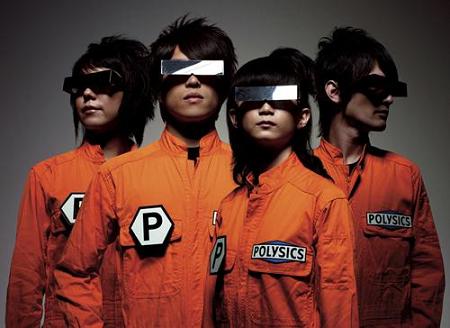
Japanese new-wave quartet Polysics can fry synapses with its sequenced vibrations, surges of thousand-gigawatt melodies, and Devo-influenced punk rock.
Front man Hiro Hayashi, 30, formed the band in 1998, endured constant lineup changes, and in 2007, caught the eye of Tom Anderson, who signed them to MySpace Records after seeing them at a US show. Since then, the band has issued a compilation of its previous foreign-release albums, Polysics or Die!, and embarked on the first-ever MySpace tour.
In an e-mail interview, Hayashi talks about his “space language” lyrics, what he thinks will be the next evolution in new wave, and what will come after the band’s eighth studio release, We Ate the Machine (MySpace Records).
On We Ate the Machine, you sing “Moog Is Love.” What other instruments do you believe communicate strong emotions?
BIAS! The motif of our song “Baby BIAS” is about an instrument that delivers vibrations. BIAS is an instrument you use by hitting it or by shaking it. We’ve been using it for such a long time that it has become an essential instrument in making/creating the Polysics sound. BIAS is such a lovable instrument that we’ve even made a track about it.
For me, being a punk rocker is not about your hair sticking up and yelling “no future” with a middle finger in the air.
You have many similarities to Devo because of your costumes and new-wave sound. What do you think is the most important creative element that you’ve borrowed from Devo?
We are inspired by their desire to make music that nobody has ever heard before.
Rock, new wave, metal, pop, dance, electronica all converge in a Polysics song. How exactly do you write your songs?
I bring in a simple demo with just a core sequence sound, plus a guitar riff, to the studio. I give instrumentation images to the members. Through numerous sessions, the arrangements eventually turn into songs.
You and the Polysix Korg synthesizer were both born about 30 years ago. What do you think is the next evolution of the new-wave sound?
The next revolution of instruments would be digital evolution of the [ancient flute] ocarina. We plan to use it to create our next album.
What is the ethos of a Japanese punk rocker?
For me, being a punk rocker is not about your hair sticking up and yelling “no future” with a middle finger in the air. It’s about doing something different.
Currently in Japan, maybe the image of punk isn’t exactly like what you’d imagine as punk. It’s about fast, sporty tunes with good melodies and a message. Most bands are enjoying the feeling of safety by making music that is similar to the others. I want Polysics to be different. That to me is punk rock.
How do you use your “space language” to communicate to fans during a song or a concert, when you want fans to feel a certain emotion?
The “space language” means that I want people to feel our music and fully absorb the powerful sound of the words in high tension.
Did creating this “space language” make you confident that you could overcome the language barrier?
I don’t really remember reading lyrics while listening to rock music growing up, and it was exciting to me to just listen to the guitar riffs, voice, drums, etc. Over time, Polysics has succeeded in warming up the audience with just music.
Our confidence grew and now we strongly believe that our music can cross over the language barrier. We rely heavily on the universal language of music, and with each show we understand better what that means and how to achieve it.
– Chris Catania
